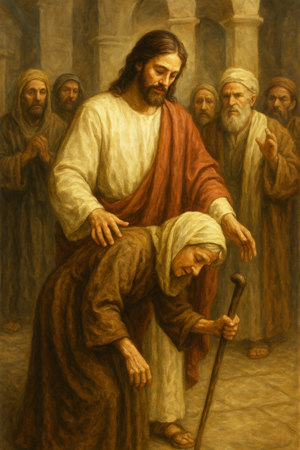
The story of the woman healed on the Sabbath after 18 years being dominated by an evil spirit is not only a tour de force of Jesus teaching, but it also tells us much about first century Israel.
After healing this women, the Jews object citing the Old Testament prohibition against work on the Sabbath in both Exodus and Deuteronomy. Jesus responds by rebuking the religious leaders for their hypocrisy. They selfishly take care of the needs of their animals on the Sabbath, but then object to meeting the greater spiritual and physical needs of a human being.
The story is framed by passages that give us a glimpse into the culture at the time:
- Sabbath … teaching in one of the synagogues (13:10). Visiting rabbis were often asked to give the sermon or homily for the synagogue service.
- A woman was there (13:11). Though women were excluded from much of Israels religious life, including access to the inner temple court in Jerusalem, they participated in synagogue worship. Jesus gives her a name – the daughter of Abraham indicating her inclusion in the community.
- Crippled by a spirit (13:11). Luke explains that the condition caused her to be stooped over, a condition many commentators have identified as spondylitis ankylopoietica. Verse 16 indicates that this was caused by demonic oppression of some sort. Demons were blamed from much when the cause wasn’t known. Demons are often described as inflicting actual illnesses, including epilepsy (Luke 9:39), muteness (Luke 11:14), lameness (here), and madness (Luke 8:29).
- Synagogue ruler (13:14). This administrative officer maintained the synagogue and organized the worship services.
- There are six days for work (13:14). This verse alludes to the prohibition to work on the Sabbath cited earlier. Notice that the synagogue ruler does not address Jesus directly, perhaps to avoid a direct confrontation or to respect his position.
- Be healed on those days, not on the Sabbath (13:14). The rabbis debated whether it was justified to offer medical help to someone on the Sabbath. It was generally concluded that it was allowed only in extreme emergencies or when a life was in danger. Since this woman’s life is not in immediate danger, the synagogue ruler considers this a Sabbath violation. Jesus does not reject the Torah’s rulings on the Sabbath, only their application. He affirms the role of the Sabbath to bring freedom to people, the original purpose of the Sabbath, in this case from the evil spirit. Both she and the crowd respond with appropriate praise to God.
- Untie his ox or donkey … lead it out to give it water (13:15). The law allowed animals go out on the Sabbath, but restricted the burdens they can carry. While restricting the kinds of knots that could be tied on the Sabbath, the rabbis allowed animals to be tied to prevent straying. They also found ways to water their animals without breaking the limits of Sabbath travel. (Sabbath travel was limited to two thousand cubits, about six-tenths of a mile, from home. They would build a crude structure around a public well, converting it into a private residence. Since the well was now a “home,” animals could be taken there for watering, provided “the greater part of a cow shall be within the enclosure when it drinks.”) Jesus points out the hypocrisy of taking such measures to protect one’s property while objecting to an act of human compassion.
- Then should not this woman … be set free on the Sabbath… ? (13:16). If an animal can be helped on the Sabbath, how much more a human being. Both the animal and women are set free, the latter by untying and the latter by Jesus. She is also blamed by the synagogue leader for being in need. He chooses to go after her rather than Jesus who it not rebuked
- His opponents were humiliated (13:17). A great orator in this time was one who could baffle and silence his opponents. It is clear that Jesus had won this one. Of course, the story is more than a clash between cultures, it is reflective of Jeus sense of compassion toward others.
